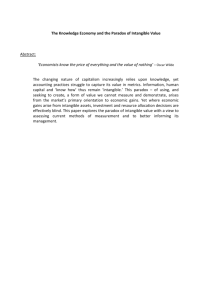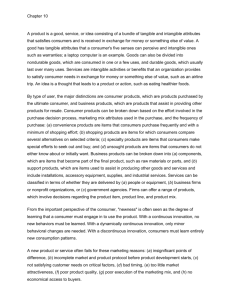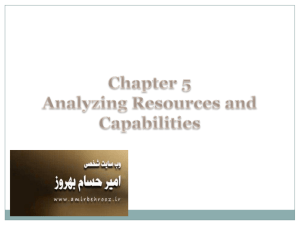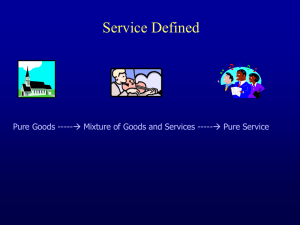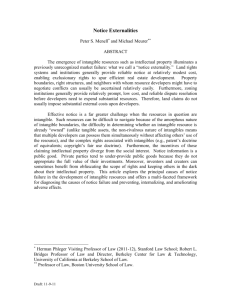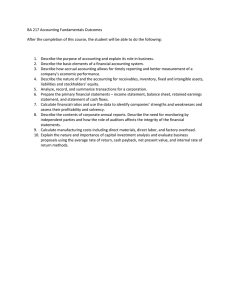Proceedings of 8th Annual London Business Research Conference
advertisement
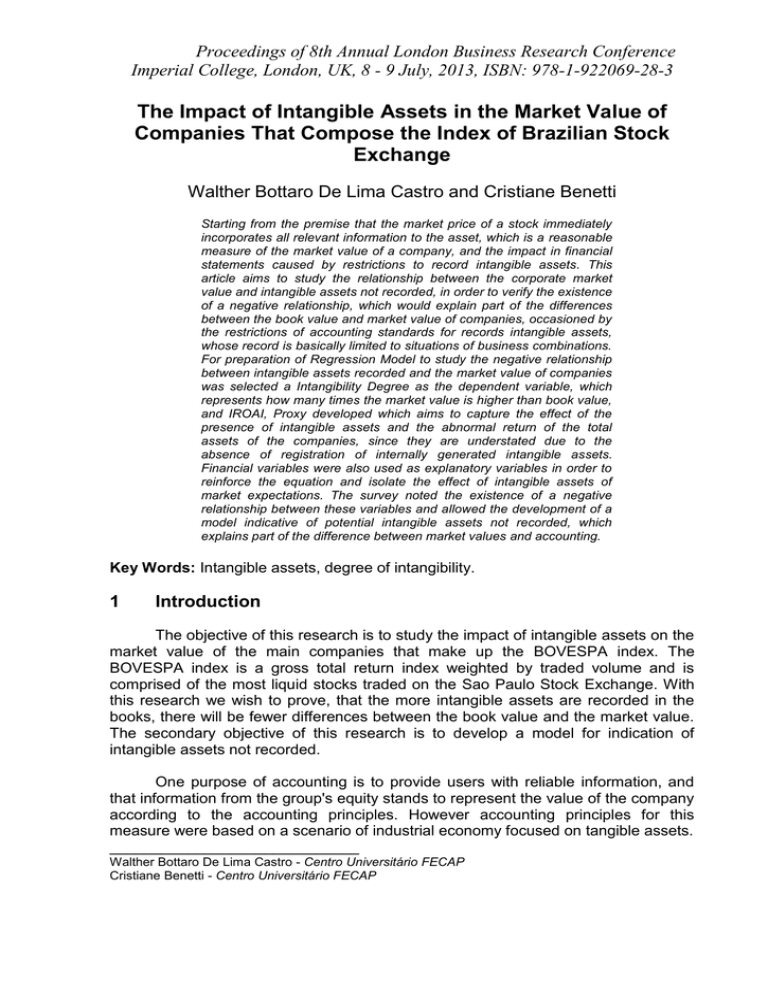
Proceedings of 8th Annual London Business Research Conference Imperial College, London, UK, 8 - 9 July, 2013, ISBN: 978-1-922069-28-3 The Impact of Intangible Assets in the Market Value of Companies That Compose the Index of Brazilian Stock Exchange Walther Bottaro De Lima Castro and Cristiane Benetti Starting from the premise that the market price of a stock immediately incorporates all relevant information to the asset, which is a reasonable measure of the market value of a company, and the impact in financial statements caused by restrictions to record intangible assets. This article aims to study the relationship between the corporate market value and intangible assets not recorded, in order to verify the existence of a negative relationship, which would explain part of the differences between the book value and market value of companies, occasioned by the restrictions of accounting standards for records intangible assets, whose record is basically limited to situations of business combinations. For preparation of Regression Model to study the negative relationship between intangible assets recorded and the market value of companies was selected a Intangibility Degree as the dependent variable, which represents how many times the market value is higher than book value, and IROAI, Proxy developed which aims to capture the effect of the presence of intangible assets and the abnormal return of the total assets of the companies, since they are understated due to the absence of registration of internally generated intangible assets. Financial variables were also used as explanatory variables in order to reinforce the equation and isolate the effect of intangible assets of market expectations. The survey noted the existence of a negative relationship between these variables and allowed the development of a model indicative of potential intangible assets not recorded, which explains part of the difference between market values and accounting. Key Words: Intangible assets, degree of intangibility. 1 Introduction The objective of this research is to study the impact of intangible assets on the market value of the main companies that make up the BOVESPA index. The BOVESPA index is a gross total return index weighted by traded volume and is comprised of the most liquid stocks traded on the Sao Paulo Stock Exchange. With this research we wish to prove, that the more intangible assets are recorded in the books, there will be fewer differences between the book value and the market value. The secondary objective of this research is to develop a model for indication of intangible assets not recorded. One purpose of accounting is to provide users with reliable information, and that information from the group's equity stands to represent the value of the company according to the accounting principles. However accounting principles for this measure were based on a scenario of industrial economy focused on tangible assets. _____________________________ Walther Bottaro De Lima Castro - Centro Universitário FECAP Cristiane Benetti - Centro Universitário FECAP Proceedings of 8th Annual London Business Research Conference Imperial College, London, UK, 8 - 9 July, 2013, ISBN: 978-1-922069-28-3 However, in recent decades the presence of intangible assets in companies increased significantly, however the rules and accounting rules not followed this tendency and still restrict the registration of internally generated intangible assets, which is permitted basically in the event of a business combination, where acquiring company records all intangible assets of the acquired company for fair value. In 1996 Kam notes that the raison d'être of accounting is to provide information to users, and according to the evolution of the economy, society, and the emergence of new technologies, user demands for information will change, and records must follow this moving, otherwise investors will seek other sources of information. Lev and Zarowin (1999) observed that the lack of intangible assets registration in the financial statements is responsible, partially, for the loss of relevance of accounting numbers in the assessment and projections of the share price of companies. In 2010, Salamudin (et al) investigated the relationship between the market value and the intangible assets by applying multiple regression, where he was considered the market value as the dependent variable, and the net value of assets and net income divided by revenues as explanatory variables. In this research Bakar, Ibrahim and Hassan (2010) observed that intangible assets are important to determine the market value of firms and found the declining importance of tangible assets. Belem and Marques (2012) analysed market expectations that are not explained by intangible assets recognized in the balance sheet and observed that the degree of intangibility of the companies has a positive impact on the return on equity. Perez and Famá (2006) found a positive relationship between intangible assets and financial variables in companies belonging to the Brazilian Bovespa Index in the years 2007 and 2008, and found that investment in intangible assets provided increased revenue and share valuation. In the theory of efficient markets (Fama 1970) the market price of a stock immediately incorporates all information relevant to the asset, which is the best estimate of the current share price (company ), and therefore the best estimate of its asset value. In this context, it may be assumed that the book value per share of a company should be close to its share price on that same date, however there are major differences between the book value, with the value traded in the market. These differences are related to market expectations and the lack of intangible assets registration in the accounting records, due to the restrictions of accounting standards. In this context, what is the impact of intangible assets on market value in companies that comprise the Bovespa index on the date of 31/12/2011? This study contributes to the academic proposing a model for calculating the intangible asset not shown in the balance sheet and contributes to the market showing the actual business potential when the intangible asset is considered. 2. Methodology The descriptive quantitative research according to Lakatos, consist of empirical research whose primary purpose is the design or analysis of the characteristics of facts or phenomena. In this sense the present work fits into the type of descriptive quantitative field research, whose goal is to test the hypothesis that the registration of intangible assets impacts negatively on the difference between the Proceedings of 8th Annual London Business Research Conference Imperial College, London, UK, 8 - 9 July, 2013, ISBN: 978-1-922069-28-3 market value and the book value of the companies that make up the BOVESPA index on December 2011. 2.1 Sample In order to verify the registration of intangible assets not interfere in the market value of companies, sought to companies listed on the São Paulo stock exchange, and are part of the Bovespa index base date of 05/11/2012. Were intentionally selected 30 companies with the highest representation in the Ibovespa theoretical portfolio, excluding banks given that the chart of accounts is different from the others, which limits the comparison of results. Of these 30 companies were obtained stock quotations annual closings of 2009, 2010 and 2011 through the base JGrafix and Financial Statements, through the website of CVM - Brazilian Securities Commission. Were excluded from the sample periods whose balance sheet information from companies was not available and the periods for which the results were negative (losses) 2.2 Variables For preparation a Regression Model that study the negative relationship between intangible assets recorded and the market value of companies was selected the Intangibility Degree as the dependent variable, which represents how many the market value is higher than book value, and total return of assets divided by the percentage of the company's intangible assets (ROAI Index) as an explanatory variable. Financial variables were also used as explanatory variables fundamentalists in order to reinforce equation and reduce the impact on of market expectations the IROAI arising from the financial indicators The pretended equation of this study is presented below: AI Degree of Intangibility Kayo 2004, Perez and Famá in 2006 and Belem and Marques in 2012 used the degree of intangibility as an analysis tool in their research. Your calculation is made by dividing the market value of the company, calculated by multiplying the number of shares at the quoted share price, divided by the net book value, as shown below: Where: GI = Degree of intangibility MV = Market Value VC = Book Value This indicator represents how many times the market value is above (or below) the book value. Kayo and Fame (2004) used this same index, assuming that more high the intangibility degree more relevant will the intangible assets in the company. In the present study also assumed that the higher the value the greater the Proceedings of 8th Annual London Business Research Conference Imperial College, London, UK, 8 - 9 July, 2013, ISBN: 978-1-922069-28-3 relevance of intangible assets in the company, since the market value of companies in the context of efficient market should be close to book value, however the limitations of record , mentioned in the previous topic, contribute to this distortion. Index ROAI As Bakar, Ibrahim and Hasan (2010) the premise of this work is that intangible assets represent a significant portion of the market value of companies. A major difficulty encountered in the preparation of Regression Model was to select a variable that captures the isolated effect of intangible assets not recorded. As already mentioned, there is a prohibition on registering the most intangible asset, exception given to a Business Combinations whose record of intangible assets is allowed. Intangible assets are relevant in the economic performance of companies and firms with higher proportion of intangible assets generate greater value for its shareholders (Perez and Famá 2005). In this line of analysis, it is expected that the lower the percentage of intangible assets recorded in relation to total assets will result greater returns on assets, since the total assets is undervalued (by the absence of internally generated intangible assets) , and in companies that already exist relevant intangible assets (acquired) recorded this relationship will reduce. In this context we developed a "Proxy" calculated by dividing the percentage of intangible assets recorded at ROA (Return on Assets). The simplified calculation of "ROAI Index" can be formed by the division of intangible assets by net income. Where: IROAI index = ROAI AI = Intangible Assets AT = Total Assets ROA = Return on assets LL = Net Income The "ROAI Index" captures the presence of intangible assets and the return "abnormal" (due to lack of intangible assets) the assets of the companies, indicating the absence of significant situations of intangible assets (abbreviated by “AI”). Table 1: Behaviour Index ROAI on Hypothetical Scenarios Scenarios Information Total Assets Intangible assets Net profit Percentage of AI ROA Low presence of AI and high return on assets Large presence of AI Low presence and high of AI and low return on return on assets assets Large presence of AI and low return on assets 1.000.000 1.000.000 1.000.000 1.000.000 50.000 500.000 50.000 500.000 150.000 150.000 15.000 15.000 5% 50% 5% 50% 15% 15% 2% 2% 0,33 3,33 3,33 33,33 Index ROAI Proceedings of 8th Annual London Business Research Conference Imperial College, London, UK, 8 - 9 July, 2013, ISBN: 978-1-922069-28-3 Table 1 shows the behaviour of the index ROAI in four hypothetical scenarios. As can be seen, the index shows the lowest values in the scenario of low presence of intangible assets and high return on company assets (ROA). It is worth noting that the ROA is inflated in part by the absence of registration of intangible assets, which increase the ROA. In order to check the validity of IROAI index in a practical scenario, was selected, through software Economática, the segments of listed companies in the São Paulo stock exchange which is expected a strong tendency in the presence of tangible assets and the segments which is expected a strong tendencies of intangible assets pressence, such as: high technologies, patents and highly skilled staff (intellectual capital). Were considered in this sample only companies that had some intangibles asset recorded and positives returns for the years 2010 and 2011, otherwise it would not be possible to calculate the IROAI in firms without intangibles or negative returns. For these companies IROAI index were calculated and grouped by the average of this indicator by segment, as shown in Table 2. Table 2: Index ROAI by Segment for the Years 2010 And 2011 Average IROAI Segments 2010 2011 0,30 0,37 2,15 0,63 2,99 2,00 7,26 6,76 11,32 6,86 9,55 7,38 21,39 7,82 10,34 11,69 6,21 18,51 12,66 34,75 Construction Chemical Software and Data Oil and Gas Food and Beverage Electricity Mining Transportation Services Telecommunications Commerce In Table 2 is possible to note a symmetrical behaviour of the IROI. In segments that believes there is high presence of intangibles mean values of the indicator were low, and segments with a strong presence of major tangible assets mean values were highs. It can be seen that in all segments with intangible tendency the index is below 3 and the segments with tangible tendency the index is above 6 Based on the information obtained can be assumed that the indicator ROAI captures the effect of the presence of intangible assets not recorded and return "abnormal" (due to the absence of registration of IAs) of the assets of the companies, indicating the absence of significant situations of intangible assets . Proceedings of 8th Annual London Business Research Conference Imperial College, London, UK, 8 - 9 July, 2013, ISBN: 978-1-922069-28-3 Fundamentalists Variables In order to isolate the effect of intangible assets and enhance the explanatory power of the regression, the following variables were selected: Return on Equity / ROE According to Assaf Neto (p. 114), and Lopes Ferreira et al (2005), this index measures the return on funds invested in the company by shareholders and is calculated by dividing net income divided by total shareholders' equity. Earnings Per Share (LPA) The Earnings Per Share (LPA) is a quotient widely used by investors to measure the profitability of an entity. According to Campos and Scherer (2001), its purpose is to indicate how profitable a venture presented by the use of the resources provided by the shareholders. According to Campos and Scherer Earnings per Share may be obtained in a simplified manner by dividing the net income by the number of shares outstanding. Book value per share (VPA) According to Bastos (2008), this performance measure is composed of the part of shareholders 'equity for each share issued at any given time, your calculation is obtained by dividing shareholders' equity by the total number of shares. Index Price / Earnings (P / L) According to Costa and Neves (1999) the index price / earnings (P / L) is determined by dividing the closing price of the share per share earnings. All 4 (four) indicators presented above provide information on the profitability of companies and are typically used by market analysts in their evaluations of investments. As the purpose of the IROAI index is to measure the size of the abnormality in the profitability calculation, when comparing the financial statements with the share prices on the stock exchange, the use of these financial indicators in the regression is significant. 2.3 Technical Statistics To test the null hypothesis that the variables do not explain the degree of intangibility of companies, we applied the t test of significance. According to Gujari and Porter (2011), a significance test is a procedure in which the sample results are used to verify the truth or falsity of the null hypothesis. Also was performed the F test to test the null hypothesis that all variables are not jointly significant for explaining the degree of intangibility of the companies, and the result was satisfactory. In the present study we used the least squares method, which consists in building a model that aims to find the effects of the independent variables on the dependent variable, minimizing the sum of squared residuals. Was elaborated the correlation matrix between variables to detect multicollinearity. According Gujari and Porter, 2011, correlation coefficients above 0.8 Proceedings of 8th Annual London Business Research Conference Imperial College, London, UK, 8 - 9 July, 2013, ISBN: 978-1-922069-28-3 may indicate a high level of multicollinearity, which would threaten the estimators of the regression. Were not identified worrying levels of correlation between variables. We conducted the Breusch-Godfrey test that allowed discard the hypothesis of autocorrelation at a significance level of 10%, and were made the Durbin-Watson and Breusch-Godfrey tests, which also allowed eliminating autocorrelation hypothesis in the sample. 3. Delimitation and Justification of Research The research is justified by appeal academic and professional with regard to the study of the impact of non-registration of intangible assets and the gap between the financial and accounting information. As well observed by Lev (1997), restricting the registration of intangible assets, limits the usefulness of accounting information for the analysis of companies that have large sums of intangibles. This research has delimitation that should be highlighted: • This study did not aim to review, opine or test the validity of accounting standards for recording intangible assets. • This article is not aimed to study the differences between US GAAP (United States generally accepted accounting principles), IFRS (international financial reporting standards) and Brazilian GAAP, and dismissed any differences, given the convergence of these standards in the theme of Intangibles. • While considering other variables, this research did not analyse the effect of other factors, which certainly have an impact to justify the difference in book value and market value of companies, for example market expectation due to future events. 4. Intangible Asset In accordance with international accounting standards - IAS 381 (1 July 2009), intangible asset is an identifiable non-monetary asset without physical substance, which is controlled by an entity as a result of past events and which is expected to result in future economic benefits to the entity. Examples of items that qualify as intangible assets: software, patents, copyrights, customer lists, relationships with customers or suppliers, customer loyalty, market share and marketing rights. For IAS 38 (July 1, 2009) spending on advertising campaigns, customer relationship and investment in intellectual capital, through the subsidy of courses for employees, cannot be recorded as intangible assets, same generating future economic benefits, because they are considered as contributions to the goodwill derived from expected future earnings (goodwill) internally generated, whose record is not allowed. According to the standard the internal goodwill does not meet the necessary criteria and in some cases it is not possible to separate the costs incurred for the internal generation of intangible assets of the regular operations of the entity. According to IAS 38 intellectual capital is often excluded from the concept of intangible assets for financial purposes due to weak control that entity owns. 1 http://www.ifrs.org/IFRSs/IFRS-technical-summaries/Documents/Port2011/IAS38.pdf Proceedings of 8th Annual London Business Research Conference Imperial College, London, UK, 8 - 9 July, 2013, ISBN: 978-1-922069-28-3 Aboody and Lev (1998) identified in his research that the recording of intangible assets provides information relevant to investors, and therefore suggest that some internally generated intangible assets, such as spending on research and development, should be recorded as assets in the financial statements. Despite the prohibitions to recording the intangible assets generated internally, IAS 38 and CPC 042 (Brazilian accounting standard equivalent to IAS 38) allows an exception to recording these intangible assets, described above, at the time of a business combination. In a business combination the acquiring company must measure and record all the assets and liabilities at fair value, it is including a identifiable intangible assets. Even the difference of the amount paid and the fair value of all identifiable assets and liabilities (when positive) is considered an intangible asset and is accounted as goodwill in the consolidated financial statement of acquiring company. As soon, this exception of IAS 38 causes an inconsistency to comparing consolidated financial statements of entities in the same segment. For example, a bank company that has a strong brand in the domestic market, which is resulted of years and years of investments in the development of your brand, probably there is no material values registered as trademarks (intangible assets), since it is a internally generated intangible asset and the recording is prohibited. However, another bank, which is starting the activities and acquire a bank already established, in order to get your market share, could register the brand of the acquired bank in a business combination scenario. Consequently this exception will result in a discrepancy and loss of comparability between these two companies, given that only one of them will have significant intangible assets recorded in the financial statements, generating a loss of comparability and can cause decisions mistakes of investors and financial analysts when they are deciding for one of these companies. In his research, Aboody and Lev (1998) present evidence that not capitalizing intangible assets is associated with errors in predicting analysts' earnings. 5 Findings Based on 47 observations was elaborated a matrix of correlations between the degree of intangibility and the explanatory variables: Table 3: Correlation between the Explanatory Variables and the Dependent Variable Correlations GI ROE - Return on Equity 0,89 Earnings per Share (LPA) -0,17 Value per Share VPA -0,50 Price / Earnings (P/L) 0,59 ROAI Index -0,16 On these indicators, we can highlight: • A strong positive correlation between GI and LPA and P/L, which shows that the higher profitability of the equity, the greater the difference between the 2 http://www.cpc.org.br/pdf/CPC04_R1.pdf Proceedings of 8th Annual London Business Research Conference Imperial College, London, UK, 8 - 9 July, 2013, ISBN: 978-1-922069-28-3 • • book value and market value, where one can obtain that this difference is due to the future expectation from shareholders. Moderate negative correlation between value per share and the degree of intangibility Correlation weak but negative between GI and ROAI index, suggesting that the higher the recording of intangible assets less will be the difference between the market value and book value. The results met the expectations of the study, emphasizing the negative correlation observed between the degree of Intangibility and ROAI index, which shows that the degree of intangibility reduces the media that there are more intangible assets recorded. Figure 1 makes clear, through the adjusted R2, the equation has great explanatory power, and by F test, allowed to reject the null hypothesis and assume that is a significant (at the 5% level) the equation. Figure 1: Descriptive Statistics - Summary of Results Extracted From Statistical Software Estatística de regressão R múltiplo 0,96 R-Quadrado 0,92 R-quadrado ajustado 0,92 Erro padrão 3,25 Observações 47 ANOVA gl SQ Regressão MQ 5 5335,707083 1067,141417 Resíduo 41 433,9857789 10,585019 Total 46 5769,692862 Betas Interseção - ROE LPA - VPA P/L IROAI - Erro padrão Stat t F 100,8162 F de significação 0% valor-P 7,22 1,568382325 -4,601540419 0,00% 24,86 1,796761153 13,83545231 0,00% 1,26 0,546033119 -2,304496431 2,63% 0,22 0,094851451 2,291851354 2,71% 0,40 0,056267952 7,035378667 0,00% 0,31 0,142153353 -2,212269883 3,26% Based on the results presented in Figure 1 was developed equation of degree Intangibility expected and explained by the variables: ROE - Return on Equity (in%), Earnings Per Share, Value per share (VPA), price / earnings and ROAI, as shown below: X1 = ROE = return on equity X2 = LPA = Earnings per share X3 = VPA = Asset Value Per Share X4 = P / L = Price per Earnings X5 = ROAI = Index Return on Intangibles Proceedings of 8th Annual London Business Research Conference Imperial College, London, UK, 8 - 9 July, 2013, ISBN: 978-1-922069-28-3 GI= -7,22 + (24,86 * ROE) + (-1,26 * LPA) + (0,22 * VPA) + (0,40 * P/L) + (-0,31* (ROAI)) Through the analysis of betas were observed that the degree of Intangibility is affected positively by variables ROE - Return on Equity (in%), and VPA Price per Earnings and negatively by varying Earnings per Share and ROAI, as expected. Transformation Model VS Real-Intangible Assets Intangible Assets Expected Based on the equation obtained for explaining the degree of intangibility, the dependent variable "Expected Intangibility Degree" (ӯ) was replaced by the Real Intangibility Degree, enabling a model that calculates the total value of intangible assets referred to it is compared with the actual recorded intangible assets and obtain the potential intangible assets not recorded. Below is shown the steps for model transformation: a) Initial regression whose dependent variable, Intangibility Degree, is expected (calculated) obtained by multiplying betas of the five dependent variables and the values of the variables. GI expected = -7,22 + (24,86 * ROE) + (-1,26 * LPA) + (0,22 * VPA) + (0,40 * P/L) + (-0,31* (ROAI)) b) Breakdown of the Index ROAI by its original formula and replacing the real GI (intangibility degree) provided by: (AI/LL) = -7,22 + (24,86 * ROE) + (-1,26 * LPA) + (0,22 *VPA) + (0,40*P/L) + (0,31) + GI c) The variable AI (intangible asset) was isolated in order to obtain the final formula that calculates the putative predicted value of the intangible asset. AI = -7,22 + (24,86 * ROE) + (-1,26 * LPA) + (0,22 * VPA) + (0,40 * P/L) + (0,31) + GI + LL*ROA Table four presents the values of the potential intangible assets not recorded, calculated based on the model developed, and compares the value of the asset is not registered with the difference between the market value and book value. Proceedings of 8th Annual London Business Research Conference Imperial College, London, UK, 8 - 9 July, 2013, ISBN: 978-1-922069-28-3 Table 4: Calculation of Intangible Assets Potentially Unregistered Which Explain, Partially, the Difference between Market Value and Book Value AI Unregistered Observation Book Value Market Value Difference Explanation NATURA 2011 BR MALLS PAR 2011 LOJAS RENNER 2011 668.174 1.250.245 15.307.700 14.057.455 5% 777.399 7.242.727 8.199.644 956.917 81% 132.060 1.154.998 5.945.765 4.790.767 3% CIA HERING 2011 267.952 710.811 5.304.938 4.594.127 6% 1.588.832 1.424.564 25.843.403 24.418.839 7% 1.912.822 8.417.170 21.840.392 13.423.222 14% 782.094 3.670.089 5.198.081 1.527.992 51% 503.761 4.922.766 3.700.390 - 0% 38.466 6.436.886 6.629.429 192.543 20% CIELO 2011 SID NACIONAL 2011 MRV 2011 CYRELA 2011 REALT PDG 2011 Vale 2011 TELEF 2010 17.647.903 146.690.367 213.052.087 66.361.720 27% 668.372 11.667.114 50.784.892 39.117.778 2% NATURA 2010 BR MALLS PAR 2010 LOJAS RENNER 2010 624.008 1.257.502 19.070.837 17.813.335 4% 623.102 5.789.398 6.928.670 1.139.272 55% 241.065 1.021.308 6.734.089 5.712.781 4% CIA HERING 2010 185.942 528.224 4.393.494 3.865.270 5% OI/BRT 2010 652.426 11.336.839 7.567.562 - 0% 1.701.703 1.194.251 42.105.408 40.911.157 4% 66.659 3.632.172 5.077.351 1.445.179 5% 2.152.736 7.822.688 38.109.618 30.286.930 7% 645.756 3.052.750 7.434.323 4.381.573 15% 594.380 4.681.937 9.530.415 4.848.478 12% BRASIL CIELO 2010 GAFISA 2010 SID NACIONAL 2010 MRV 2010 CYRELA 2010 REALT Vale 2010 NATURA 2009 CIELO 2009 12.147.906 601.211 1.470.411 116.326.862 251.196.878 134.870.016 9% 1.139.822 13.919.429 12.779.607 5% 860.429 44.598.622 43.738.193 3% Table 4 show the percentage that the intangible asset unregistered explain the difference between market value and book value, which should highlight BR MALLS PAR 2011, BR MALLS PAR 2010 and MRV 2011, whose intangible assets Proceedings of 8th Annual London Business Research Conference Imperial College, London, UK, 8 - 9 July, 2013, ISBN: 978-1-922069-28-3 unregistered explained respectively 81% 55% and 51% of the difference between market value and book value. 6. Final Comments This paper studied the impact of intangible assets on the market value of the major companies that comprise the Bovespa (São Paulo stock exchange) index, presenting a critical perspective about the intangible assets accouting. This study found that beta of IROAI index is negative, thereby demonstrating the existence of a negative relationship between the market value of companies and the lack of intangible assets recording. Consequently, were noted a smaller gap of book value to market value, represented in this article by Degree Phasing (GI), which may suggest that the higher the recording of intangible assets are allowed smaller will be the difference between the value accounting and market value. Given the relevance of intangible assets and the impact they have on the evaluation of public traded companies, it is expected that in the future the recording will be allowed, or at least, the disclose of the fair value of internally generated intangible assets will be mandatory. Certainly, the recognition of these values will increase the relevance of accounting information to stakeholders. This paper presented a model for measuring intangible assets in potentially unregistered companies, which allowed us to verify that the intangible asset potential unregistered, explains significantly, in some cases, the difference between the book value and market value. It is noteworthy that this model only indicates the possible existence of relevant intangible assets not recorded in the companies, not intended to be the basis for accounting purposes. Future studies could apply the model and to study in detail these Companies may have material intangible assets not recorded, seeking detailed identification and measurement of these intangible assets. References ABOODY, LEV B. - The Value Relevance of Intangibles: The Case of Software Capitalization Journal of Accounting Research.Vol. 36, Studies on Enhancing the Financial Reporting Model (1998), pp. 161-191 BASTOS, E. C., Análise dos indicadores econômico-financeiro relevantes para avaliação de empresas, 2008 BELEM, V.& MARQUES, M. A influencia dos ativos intangíveis na rentabilidade do patrimônio líquido das empresas brasileiras, 12º Congresso USP de Controladoria e Contabilidade, 2012 CAMPOS, G.M e SCHERER, L.M. 2001 Lucro Por Ação. Revista Contabilidade & Finanças FIPECAFI - FEA - USP, São Paulo, FIPECAFI, v.15, n. 26, p. 81 - 94, maio/agosto 2001 COSTA, N.C.A e NEVES, M.B.E, Variáveis Fundamentalistas e os Retornos das Ações, RBE Rio de Janeiro, Jan/Mar. 2000 FAMA, F., 1970, "Efficient Capital Markets: A Review of Theory and Empirical Work,"Journal of Finance 25, pp. 383-417. FERREIRA. A.P. e LOPES, L.N., 2005 Indicadores Contabeis x EVA: Um estudo setorial, Proceedings of 8th Annual London Business Research Conference Imperial College, London, UK, 8 - 9 July, 2013, ISBN: 978-1-922069-28-3 FAMÁ, R.; PEREZ, M. M. Ativos intangíveis e o desempenho empresarial. Revista de Contabilidade & Finanças – USP, n. 40, p. 7 – 24, 2006 GUJARATI, D.N. & PORTER, D.C. Econometria Básica. Porto Alegre, Editora Afiliada, 2011. KAYO, E. e FAMA, R. A estrutura de capital e o risco das empresas tangivelintensivas e intangivel-intesivas, R.Adm., São Paulo, v39, pp164-176, 2004 KAM., V. Accounting Theory, California State University Harvard - Second Edition 1990. LAKATOS, E. M. & MARCONI, M. A. Fundamento de metodologia cientifica. São Paulo: Atlas, 2010. LEV, B.; ZAROWIN, P. The Boundaries of Financial Reporting and How to Extend Them. Journal of Accounting Research 37, no. 2 (autumn), 1999, p.353-85. LEV B.; RADHAKRISHNAN S. The Measurement Of Firm-Specific Organization Capital. NBER Working Paper Series, Massachusetts Avenue, Cambridge, March 2003, Disponível em <http://www.nber.org/papers/w9581>, Acesso em 2005. ROBERTS, H., 1967, Statistical versus Clinical Prediction of the Stock Market", unpublished manuscript, Center for Research in Security Prices, University of Chicago. SALAMUDIN ., BAKAR R., IBRAHIM M.K., HASSAN F.H., "Intangible assets valuation in the Malaysian capital market", Journal of Intellectual Capital, 2010, Vol. 11 Iss: 3, pp.391 - 405
